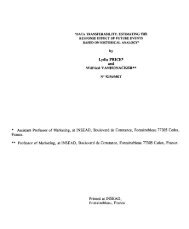* Assistant Professor of Operations Management at INSEAD ...
* Assistant Professor of Operations Management at INSEAD ...
* Assistant Professor of Operations Management at INSEAD ...
Create successful ePaper yourself
Turn your PDF publications into a flip-book with our unique Google optimized e-Paper software.
<strong>of</strong> system st<strong>at</strong>us (e.g., number <strong>of</strong> customers <strong>of</strong> each type present). More<br />
general policies are dynamic, or system-st<strong>at</strong>us dependent. Th<strong>at</strong> means th<strong>at</strong><br />
the decision <strong>of</strong> who to serve next depends on the customer mix present in<br />
the queue, e.g., on the number <strong>of</strong> customers <strong>of</strong> each type currently waiting.<br />
An important special policy is the st<strong>at</strong>ic priority ranking policy (preemptive<br />
or non-preemptive), which always grants service next to the customer in the<br />
queue who is <strong>of</strong> the type with the lowest index (the highest product cp),<br />
regardless <strong>of</strong> the st<strong>at</strong>e <strong>of</strong> the system. This policy is important because it has<br />
been shown to minimize total waiting cost in the system if the arrival r<strong>at</strong>es<br />
An are given.<br />
Throughout the paper, I consider only Nash equilibria in pure str<strong>at</strong>egiesl.<br />
To avoid degeneracies, I assume th<strong>at</strong> p i > 1/P„(0) for all i. Any firm th<strong>at</strong><br />
does not meet this condition has so little capacity (performs service so slowly)<br />
th<strong>at</strong> even without any congestion, orders take so long th<strong>at</strong> no customers are<br />
interested. In th<strong>at</strong> case, this firm will not produce anything in equilibrium.<br />
As is evident in the description <strong>of</strong> the model, customers subscribe to a<br />
firm's services r<strong>at</strong>her than go out and search for the best deal whenever<br />
the need for an order arises, i. e., they place orders st<strong>at</strong>ically r<strong>at</strong>her than<br />
dynamically. This simplifies analysis and reflects the fact th<strong>at</strong> suppliers <strong>of</strong>ten<br />
have longterm rel<strong>at</strong>ionships with their customers. Furthermore, the linear<br />
waiting cost structure makes the qualit<strong>at</strong>ive results in models with dynamic<br />
customer decisions similar (see, e.g., Li and Lee (1991)).<br />
In order to interpret the product <strong>of</strong> waiting cost and average service r<strong>at</strong>e,<br />
the reader may look <strong>at</strong> two extreme cases. First, consider the situ<strong>at</strong>ion when<br />
all customer groups have the same service times, or p n = p for all n. In this<br />
case, group 1 is the most imp<strong>at</strong>ient group, and increasing n means decreasing<br />
imp<strong>at</strong>ience. The second extreme case occurs when all waiting cost r<strong>at</strong>es are<br />
the same, cn = c for all n. In this case, group 1 is the fastest processed group,<br />
and increasing n means decreasing speed <strong>of</strong> service. The group identific<strong>at</strong>ion<br />
criterion is thus a combin<strong>at</strong>ion <strong>of</strong> imp<strong>at</strong>ience and service speed; both high<br />
imp<strong>at</strong>ience or high service speed can result in a high ranking (low index) <strong>of</strong><br />
a group.<br />
With the customer groups, the model introduces an asymmetry in the<br />
market (as opposed to an asymmetry between the firms), and the next section<br />
will examine whether this asymmetry allows the existence <strong>of</strong> asymmetric<br />
equilibria in this industry.<br />
'Pure str<strong>at</strong>egies exclude a firm from having several altern<strong>at</strong>ive str<strong>at</strong>egies, among which<br />
it randomly picks one.<br />
7















